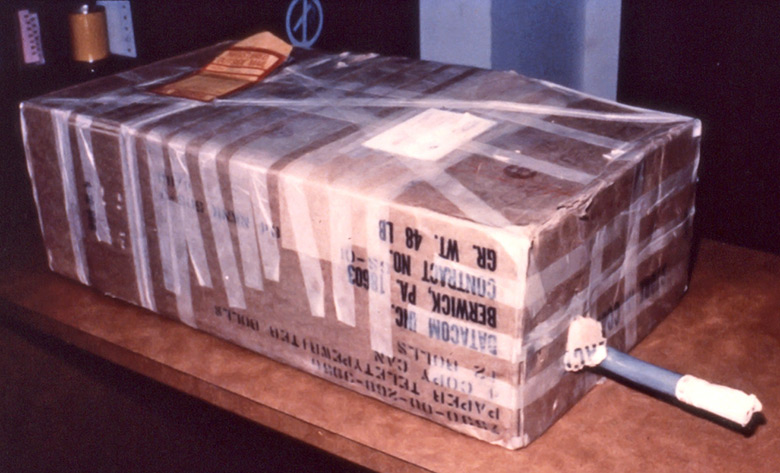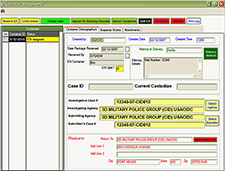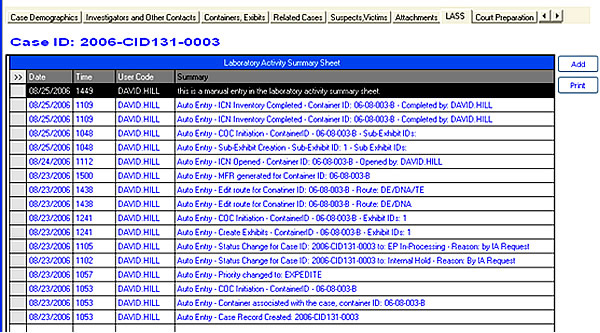Home | Glossary | Resources | Help | Contact Us | Course Map
Archival Notice
This is an archive page that is no longer being updated. It may contain outdated information and links may no longer function as originally intended.
Laboratory Evidence Handling
Most jurisdictions have their own specific requirements in regard to evidence handling.
The general principles are
- safety,
- integrity,
- chain of custody.
Safety
Upon arrival at the laboratory evidence reception area, a number of initial safety concerns must be addressed. Depending upon the protocols of a given laboratory, these safety concerns are the responsibility of the evidence reception personnel and/or the examiner initially receiving the evidence.
Safety concerns include the following areas:
- Determine that each firearm is in a safe (properly unloaded) condition.
- Evaluate the safe packaging of potential biohazards, such as blood-stained clothing.
- Ensure that any tool considered a sharp is properly packaged and contained.
Integrity
The laboratory must store the evidence in environmental conditions that ensure its integrity. Many laboratory facilities have dedicated areas for the drying of biological evidence. All have temperature-controlled chambers or rooms allocated for the storage of biological material and reagents that are affected by temperature and humidity.
Most laboratories have strict evidence acceptance procedures and will not accept evidence unless it has been properly packaged to prevent loss or contamination.
The general principle of packaging to preserve the integrity of evidence should also apply to evidence that is awaiting disposition or that has been transferred to the custody of the court. Further testing or re-testing may be required at some future date.
Chain of Custody
Passage of evidence into the control of the laboratory must be effected with proper attention to chain of custody. Records of the receipt, within-laboratory transfers, and disposition of evidence out of the custody of the laboratory must be complete and permit full reconstruction of events.
Computer-based laboratory information management systems (LIMS) are now widely used; many systems permit integration of analysis data with chain-of-custody information. Many jurisdictions have their own standard forms to record receipt and internal and external evidence transfers.
Case Tracking Within the Laboratory
Crime laboratories must have in place a system that allows for the tracking of the
- status of an individual submission of evidence,
- overall caseload status within a given discipline, subdiscipline, unit, or section.
System goals are to organize information in a manner that enables all personnel to
- actively manage cases in a systematic way,
- discuss case status with client agencies,
- respond to inquiries from senior management.
Additional Online Courses
- What Every First Responding Officer Should Know About DNA Evidence
- Collecting DNA Evidence at Property Crime Scenes
- DNA – A Prosecutor’s Practice Notebook
- Crime Scene and DNA Basics
- Laboratory Safety Programs
- DNA Amplification
- Population Genetics and Statistics
- Non-STR DNA Markers: SNPs, Y-STRs, LCN and mtDNA
- Firearms Examiner Training
- Forensic DNA Education for Law Enforcement Decisionmakers
- What Every Investigator and Evidence Technician Should Know About DNA Evidence
- Principles of Forensic DNA for Officers of the Court
- Law 101: Legal Guide for the Forensic Expert
- Laboratory Orientation and Testing of Body Fluids and Tissues
- DNA Extraction and Quantitation
- STR Data Analysis and Interpretation
- Communication Skills, Report Writing, and Courtroom Testimony
- Español for Law Enforcement
- Amplified DNA Product Separation for Forensic Analysts




